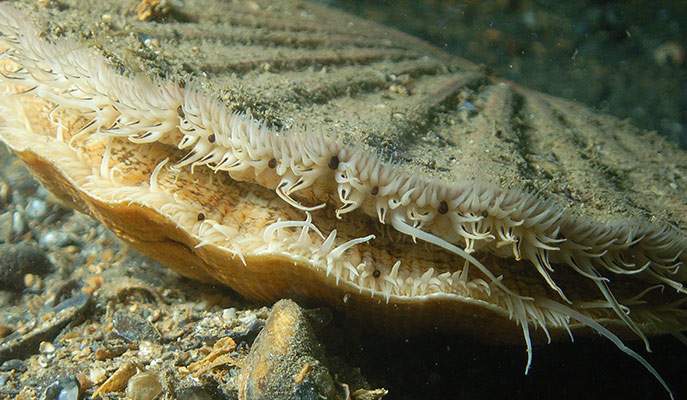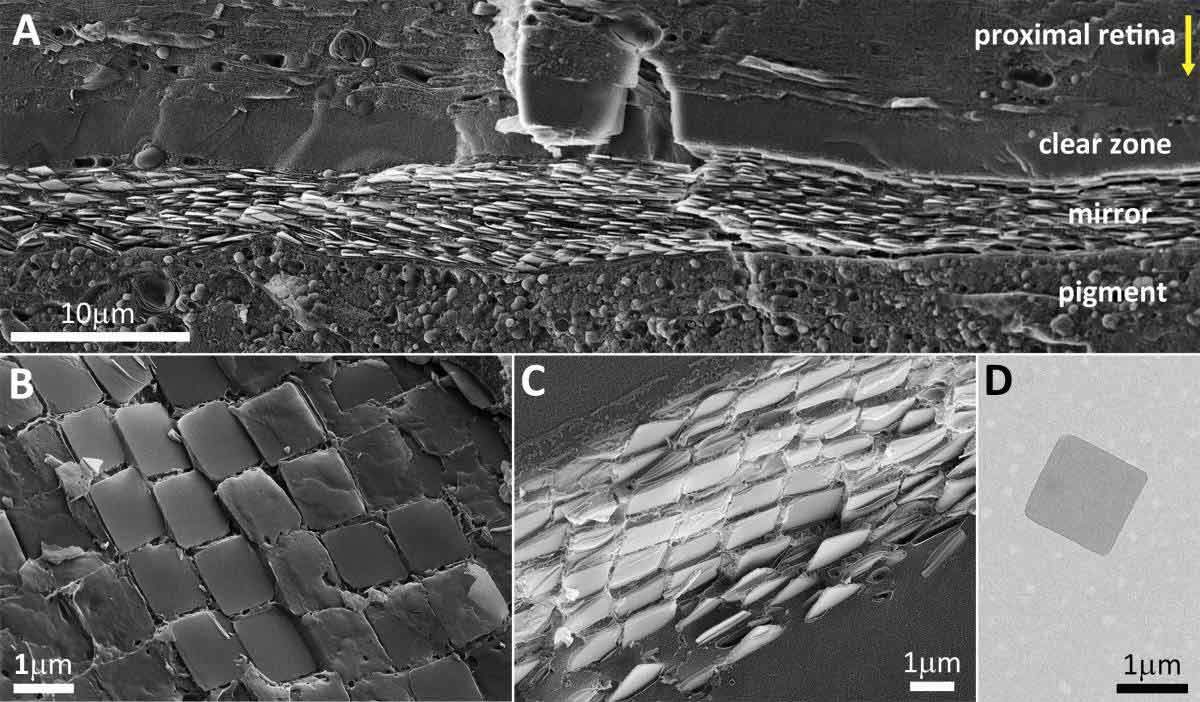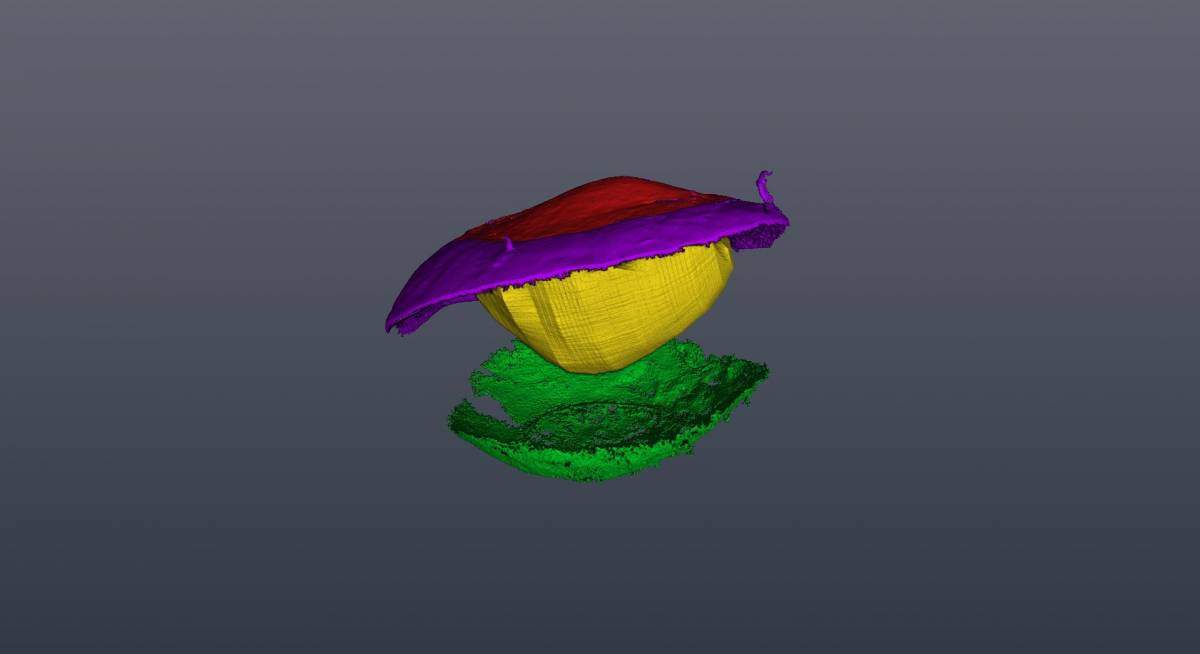Are you a journalist? Please sign up here for our press releases
Subscribe to our monthly newsletter:

Scallops see with up to 200 tiny eyes, which ring their bodies. But this is not the most unusual feature of their visual system: Instead of focusing light through a lens, scallop eyes possess a mirror at the back of the eye to reflect light onto two different retinas. How do these tiny mirrors create visual images? A team of scientists at the Weizmann Institute of Science in Israel and Lund University in Sweden has now explained in detail the construction of this mirror and its optical properties. Their findings were reported in Science.
Scallops, like their relatives the clams, normally sit on the ocean bed; unlike most clams, they can also swim. In addition, scallops sport iridescent blue eyes dotting the upper and lower edges of their round bodies.
Dr. Benjamin Palmer, a postdoctoral fellow in the groups of Profs. Lia Addadi and Steve Weiner of the Weizmann Institute of Science’s Structural Biology Department, points out that fully understanding these complex eyes involved a collaboration between physicists, chemists and biologists. They combined several cutting-edge techniques as well as simulations to put together a picture from the nanoscale to the millimeter-scale, to reveal how light is focused in this unique system.

On the nanoscale, the mirror lining the back of the eye is made of tiny crystals of guanine. Addadi, Weiner and others have previously shown that when these transparent crystals are arranged into multilayers they are able to reflect light; they have observed this property in silvery fish scales, the protective covering of spiders and the outer layers of iridescent crustaceans. Electron microscopy revealed that the crystals in scallop-eye mirrors are almost perfect squares, and these tile the mirror’s surface. The team analyzed these tiles in detail, revealing their optical properties, including how the nanoscale structure of this material produces a highly effective reflective surface. “These tiles are arranged something like the individual mirrors that make up a large telescope mirror,” says Palmer. “The large reflecting telescopes are typically made with many small hexagonal or square mirrors that are tightly tessellated together.” “The square tiles in the scallop eyes also fit snugly, leaving no gaps to create aberrations in the image they reflect,” adds Prof. Dan Oron, of the Institute’s Physics of Complex Systems Department.
The group discovered that the multilayer structure of the mirror is constructed in a way that efficiently reflects the wavelengths of light that penetrate the scallops’ ocean habitat – with a peak in the blue range of wavelengths, as might be expected.
They can clearly make out the form of an approaching starfish coming to prey on them
Moving up to the next level, the group revealed the three-dimensional structure of the scallop eye. Together with Dr. Gavin Taylor of Lund University, they investigated what happens to a ray of light as it passes through the thin, non-functional lens, the inside of the eye and both retinas, and then reflects back off the mirror to the retinas. The ray-tracing simulations they conducted showed that light from different angles of incidence reflects from different parts of the curved surface of the mirror and is focused at different heights above the mirror on to one retina or the other. The analysis suggests that one of the two retinas may be used for peripheral vision in dim light while the other is better focused on the eye’s central line of vision. Further simulations and experiments revealed that this visual system is an efficient solution for producing a relatively well-focused image in the scallop’s compact eye.

“Each eye can really see shapes – not just light and dark as many sea creatures do,” says Addadi. “They can clearly make out the form of an approaching starfish coming to prey on them.”
“We can see that there is really a very high level of control in directing the growth of the guanine crystals,” adds Weiner. “Because the mirrors are so small, there is little room for error in their curvature.”
It is no surprise to the researchers that this rare and unusual visual system evolved in the ocean. Vision first arose in the ocean, and it has evolved several unique forms there. “It is much harder to see under water than in air, as we land creatures do,” says Oron, “so there are quite a few varied visual systems to be found in sea creatures. Lenses may ultimately be more effective for focusing light, but the mirrors in the scallop eye work surprisingly well,” he adds.
“We still don’t know exactly what the scallop sees through its 200 eyes,” says Addadi, “as the animal supposedly has no brain, as we do, to process the images. But there is evidence of some kind of coordination between its numerous eyes.”
“Aside from uncovering the workings of this fascinating biological optical system,” says Palmer, “this study was unique in the way it wove the ‘story’ from so many different scales and methods. We would not have been able to understand how the system works without the contribution of each and every one of us.”
Also participating in this research were Drs. Vlad Brumfled and Nadav Elad of the Chemical Research Support Department, Dr. Dvir Gur of the Molecular Cell Biology and Physics of Complex Systems Department, , Dr. Michal Shemesh of the Structural Biology and Molecular Cell Biology Departments, and M.Sc. student Aya Osherov.
Prof. Lia Addadi's research is supproted by the Jeanne and Joseph Nissim Foundation for Life Sciences Research. Prof. Lia Addadi is the incumbent of the Dorothy and Patrick Gorman Professorial Chair.
Prof. Dan Oron's research is supported by the Mary and Tom Beck - Canadian Center for Alternative Energy Research; the Deloro Institute for Advanced Research in Space and Optics; the Crown Photonics Center; the Leona M. and Harry B. Helmsley Charitable Trust; the Wolfson Family Charitable Trust; Dana and Yossie Hollander; and the European Research Council.
Prof. Stephen Weiner's research is supported by the Dangoor Accelerator Mass Spectrometer Laboratory; the estate of George and Beatrice F. Schwartzman; and the European Research Council. Prof. Weiner is the incumbent of the Dr. Walter and Dr. Trude Borchardt Professorial Chair in Structural Biology.